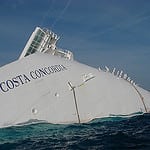Investigation blames Costa Concordia disaster on captain's antics and crew's ineptitude

Skift Take
Captain Schettino lost both his career and integrity by making every wrong decision possible, and both Costa and parent company Carnival are likely to come under closer scrutiny for both their safety procedures and their crews' credentials.
Court-appointed experts have squarely blamed the captain of a cruise ship that ran aground off Italy for the wreckage and deaths of 32 people, but they also faulted the crew and ship owner for a series of blunders, delays and safety breaches that contributed to the disaster.
The Costa Concordia ran aground and capsized off the Tuscan island of Giglio on Jan. 13 after Capt. Francesco Schettino took it off course and brought it close to the island as part of a stunt. He is accused of manslaughter, causing the shipwreck and abandoning the ship before all passengers were evacuated.
Eight other people, among them crew members and Costa's crisis coordinator, are also under investigation. The court in Grosseto ordered the expert investigation to help it determine who, if anyone, should be put on trial. A hearing is scheduled for next month.
[caption id="" align="alignright" width="350"] Captain Schettino watched from shore as his passengers were forced to jump ship. Photo by European Commission DG ECHO.[/caption]
In a 270-page analysis, the four experts described in
